![]()
![]()
![]()
Use LEFT and RIGHT arrow keys to navigate between flashcards;
Use UP and DOWN arrow keys to flip the card;
H to show hint;
A reads text to speech;
14 Cards in this Set
- Front
- Back
|
Autosomal Dominant Disorders, definition
Mnemonic for autosomal dominant disorders is : |
AD = usually structural problems.
Autosomal Dominant Disorders= only need to get the abnormal gene from one parent in order for you to inherit the disease. Mnemonic for autosomal dominant disorders is : S P C HME MED MC KD MH EDS OI O O P – Pseudo hypoparathyroidism D – Dystrophia O – Osteogenesis imperfecta/Osler-weber-rendu M – Marfans syndrome--O N – Neurofibramatosis A – Achondroplasia, -O N – Noonans syndrome H – Huntington’s disease "Very Powerful DOMINANT Humans" |
|
|
AR, definition, TO REMEMBER ABOUT AR
MNEUMONIC |
an autosomal recessive disorder means two copies of an abnormal gene must be present in order for the disease or trait to develop.
mostly enzyme deficiencies or issues w/ protein folding... a---- b-----beta thalassemia c----- d-----deafness(SNHL),dubin johnson e-----enzyme deficiencies(glycogen storage and lysosomal storage) f------friedrich's ataxia, g-----,gauchers h------HYPOPHOSPATSIA O-OI 2& 3, OSTEOPETROSIS s----sickle cell disease p----phenylketonuria w-----wilson's |
|
|
X-linked Recessive disorders:
MNEUMONIC |
1X-linked diseases usually occur in males. Males have only one X chromosome. A single recessive gene on that X chromosome will cause the disease.
Bob's Father Has GOLD Wagon B- BECKER'S MUSCULAR DYSTROPHY F - fabry's H - hunter's/ hemophilia A and B G - G6PD deficiency D -D duchenne's muscular dystrophy SED TARDA |
|
|
Imprinting define
Examples |
genetic imprinting: the allele that is expressed is determined solely on which parent contributes it.
Angelman Syndrome Prader-Willi Syndrome In Angelman syndrome the defective gene comes from the mother, leading to epilepsy, tremors, and smiling facies. In Prader-Willi syndrome the defective gene comes from the father resulting in hypotonia, obesity, hypogonadism. These are classic examples of genetic imprinting in humans. Usually, diseases resulting from defective structural proteins are autosomal dominant, while defective enzymes are autosomal recessive. |
|
|
Anticipation, define
ex |
a phenotype occurs earlier (and typically worse) in each subsequent generation
common in trinucleotide repeat disorders present earlier and more severely in affected subjects than their than affected parent. Huntington's disease |
|
|
xlinked dominate
|
indicates that a gene responsible for a genetic disorder is located on the X chromosome, and only one copy of the allele is sufficient to cause the disorder when inherited from a parent who has the disorder.
X-linked dominant traits do not necessarily affect males more than females (unlike X-linked recessive traits). The exact pattern of inheritance varies, depending on whether the father or the mother has the trait of interest. All daughters of an affected father will also be affected but none of his sons will be affected (unless the mother is also affected). In addition, the mother of an affected son is also affected (but not necessarily the other way round). Hypophosphatemic rickets Leri-Weill dyschondrosteosis (bilateral Madelung's deformity) |
|
|
Multiple inheritance patterns
|
CMT (AD, AR, Xlink)(myelin protein 22)
Osteopetrosis (AD, AR) Osteogenesis Imperfecta (AR, AD) Neurofibromatosis (AD, AR)(neurofibromin protein) SED (AD, Xlink)(COL2A1, Type II collagen) |
|
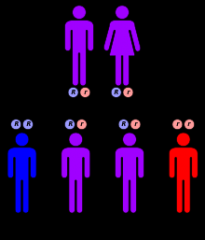
pedigree chart AR
% of offspring |
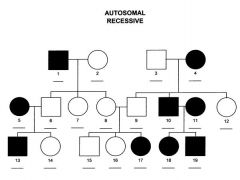
As both parents are heterozygous for the disorder, the chance of two disease alleles being inherited by one of their offspring is 25% (in autosomal dominant traits this is higher). 50% of the children (or 2/3 of the remaining ones) are carriers. When one of the parents is homozygous, the trait will only show in his/her offspring if the other parent is also a carrier. In that case, the chance of disease in the offspring is 50%.
T t T TT Tt t tT tt |
|
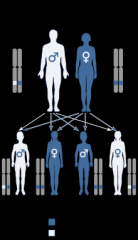
pedigree chart AD
% of offspring |
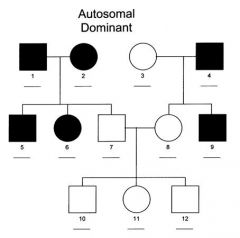
AA, AB, and BB. If AA and BB individuals (homozygotes) show different forms of some trait (phenotypes), and AB individuals (heterozygotes) show the same phenotype as AA individuals, then allele A is said to dominate or be dominant to or show dominance to allele B, and B is said to be recessive to A. If instead AB has the same phenotype as BB, B is said to be dominant to A.
|
|
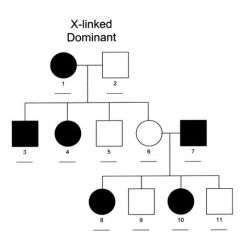
pedigree chart X-Linked dominate
% of offspring mom |
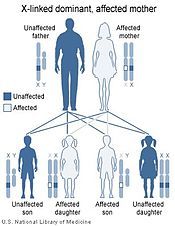
when the mother alone is the carrier of a mutated, or defective gene associated with a disease or disorder; she herself will have the disorder. Her children will inherit the disorder as follows:
Of her daughters and sons: 50% will have the disorder, 50% will be completely unaffected. Children of both genders have an even chance of receiving either of their mother's two X chromosomes, one of which contains the defective gene in question. X-linked dominant traits do not necessarily affect males more than females (unlike X-linked recessive traits). The exact pattern of inheritance varies, depending on whether the father or the mother has the trait of interest. All daughters of an affected father will also be affected but none of his sons will be affected (unless the mother is also affected). In addition, the mother of an affected son is also affected (but not necessarily the other way round). |
|
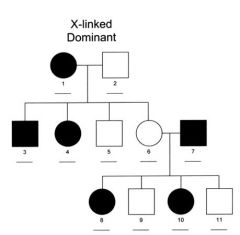
pedigree chart X-Linked dominate
% of offspring dad |
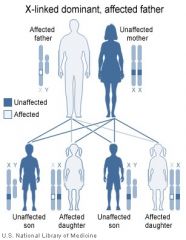
When the father alone is the carrier of a defective gene associated with a disease or disorder, he too will have the disorder. His children will inherit the disorder as follows:
Of his daughters: 100% will have the disorder, since all of his daughters will receive one copy of his single X chromosome. Of his sons: none will have the disorder; sons do not receive an X chromosome from their father. |
|
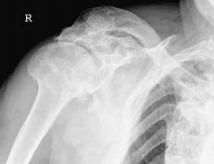
most common etiology of neuropathic shoulder arthropathy
|
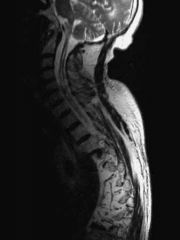
syringomyelia
most common etiology of neuropathic shoulder arthropathy 25% of these patients develop a neuropathic joint monoarticular (shoulder > elbow) Hansen's disease (leprosy) second most common cause of neuropathic shoulder arthropathy syphilis usually affects the knee can be polyarticular diabetes most common cause of |
|
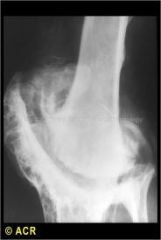
most common etiology of neuropathic knee arthropathy
|
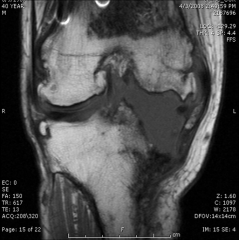
syphilis
Charcot joint is a contraindication for a total joint replacement |
|
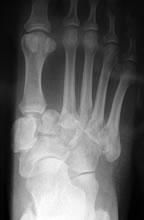
most common etiology of neuropathic foot arthropathy
|

arthrodesis
do not attempt during acute inflammatory stage (Eichenholtz 0-2) because of continued bone erosion only perform during quiescent stage (Eichenholtz 3) requires long periods of immobilization |

